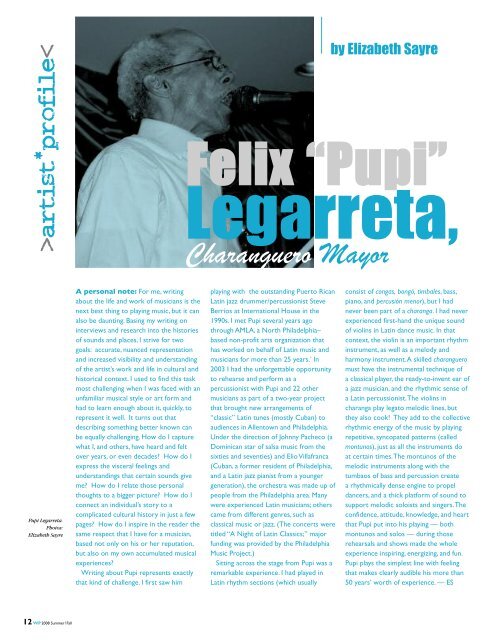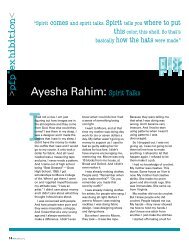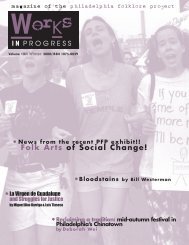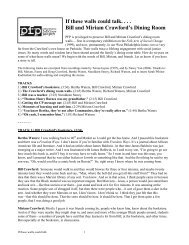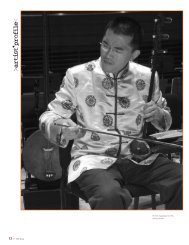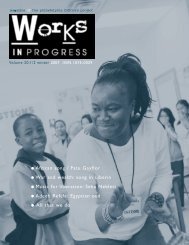View PDF - Philadelphia Folklore Project
View PDF - Philadelphia Folklore Project
View PDF - Philadelphia Folklore Project
Create successful ePaper yourself
Turn your PDF publications into a flip-book with our unique Google optimized e-Paper software.
artist*profile<<br />
by Elizabeth Sayre<br />
Felix “Pupi”<br />
Legarreta,<br />
Charanguero Mayor<br />
Pupi Legarreta.<br />
Photos:<br />
Elizabeth Sayre<br />
A personal note: For me, writing<br />
about the life and work of musicians is the<br />
next best thing to playing music, but it can<br />
also be daunting. Basing my writing on<br />
interviews and research into the histories<br />
of sounds and places, I strive for two<br />
goals: accurate, nuanced representation<br />
and increased visibility and understanding<br />
of the artist’s work and life in cultural and<br />
historical context. I used to find this task<br />
most challenging when I was faced with an<br />
unfamiliar musical style or art form and<br />
had to learn enough about it, quickly, to<br />
represent it well. It turns out that<br />
describing something better known can<br />
be equally challenging. How do I capture<br />
what I, and others, have heard and felt<br />
over years, or even decades How do I<br />
express the visceral feelings and<br />
understandings that certain sounds give<br />
me How do I relate those personal<br />
thoughts to a bigger picture How do I<br />
connect an individual’s story to a<br />
complicated cultural history in just a few<br />
pages How do I inspire in the reader the<br />
same respect that I have for a musician,<br />
based not only on his or her reputation,<br />
but also on my own accumulated musical<br />
experiences<br />
Writing about Pupi represents exactly<br />
that kind of challenge. I first saw him<br />
playing with the outstanding Puerto Rican<br />
Latin jazz drummer/percussionist Steve<br />
Berrios at International House in the<br />
1990s. I met Pupi several years ago<br />
through AMLA, a North <strong>Philadelphia</strong>–<br />
based non-profit arts organization that<br />
has worked on behalf of Latin music and<br />
musicians for more than 25 years. * In<br />
2003 I had the unforgettable opportunity<br />
to rehearse and perform as a<br />
percussionist with Pupi and 22 other<br />
musicians as part of a two-year project<br />
that brought new arrangements of<br />
“classic” Latin tunes (mostly Cuban) to<br />
audiences in Allentown and <strong>Philadelphia</strong>.<br />
Under the direction of Johnny Pacheco (a<br />
Dominican star of salsa music from the<br />
sixties and seventies) and Elio Villafranca<br />
(Cuban, a former resident of <strong>Philadelphia</strong>,<br />
and a Latin jazz pianist from a younger<br />
generation), the orchestra was made up of<br />
people from the <strong>Philadelphia</strong> area. Many<br />
were experienced Latin musicians; others<br />
came from different genres, such as<br />
classical music or jazz. (The concerts were<br />
titled “A Night of Latin Classics;” major<br />
funding was provided by the <strong>Philadelphia</strong><br />
Music <strong>Project</strong>.)<br />
Sitting across the stage from Pupi was a<br />
remarkable experience. I had played in<br />
Latin rhythm sections (which usually<br />
consist of congas, bongó, timbales, bass,<br />
piano, and percusión menor), but I had<br />
never been part of a charanga. I had never<br />
experienced first-hand the unique sound<br />
of violins in Latin dance music. In that<br />
context, the violin is an important rhythm<br />
instrument, as well as a melody and<br />
harmony instrument. A skilled charanguero<br />
must have the instrumental technique of<br />
a classical player, the ready-to-invent ear of<br />
a jazz musician, and the rhythmic sense of<br />
a Latin percussionist. The violins in<br />
charanga play legato melodic lines, but<br />
they also cook! They add to the collective<br />
rhythmic energy of the music by playing<br />
repetitive, syncopated patterns (called<br />
montunos), just as all the instruments do<br />
at certain times. The montunos of the<br />
melodic instruments along with the<br />
tumbaos of bass and percussion create<br />
a rhythmically dense engine to propel<br />
dancers, and a thick platform of sound to<br />
support melodic soloists and singers. The<br />
confidence, attitude, knowledge, and heart<br />
that Pupi put into his playing — both<br />
montunos and solos — during those<br />
rehearsals and shows made the whole<br />
experience inspiring, energizing, and fun.<br />
Pupi plays the simplest line with feeling<br />
that makes clearly audible his more than<br />
50 years’ worth of experience. — ES<br />
12 WIP 2008 Summer / Fall


